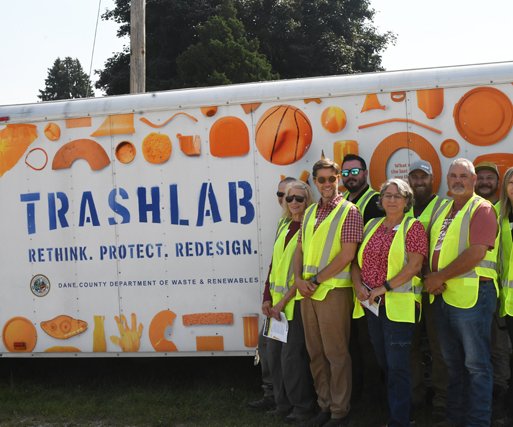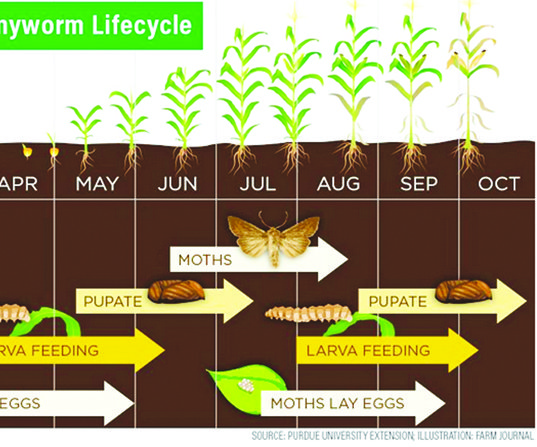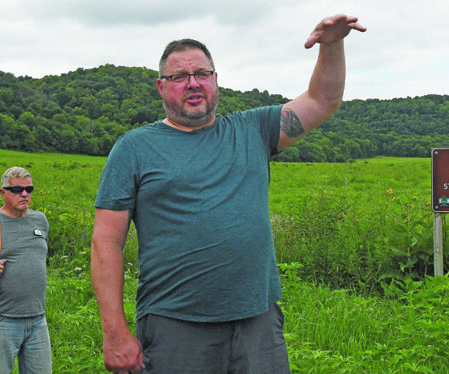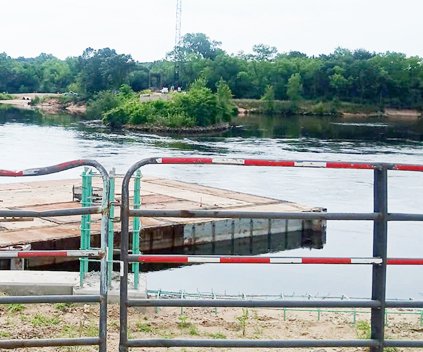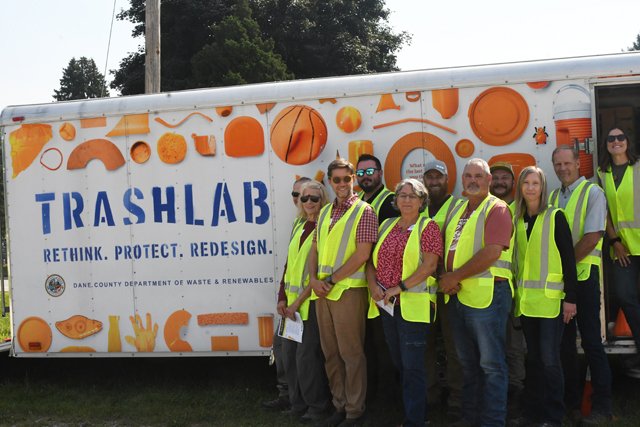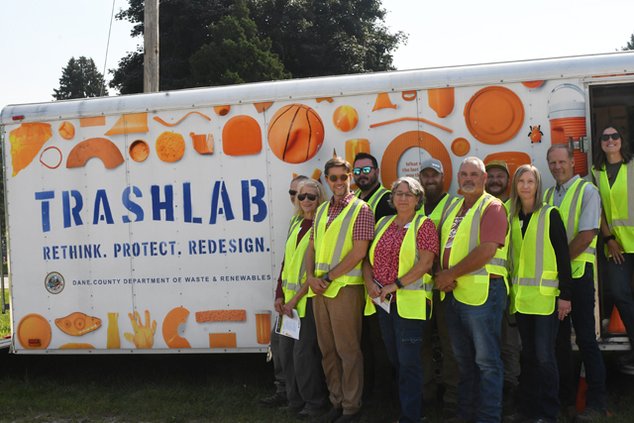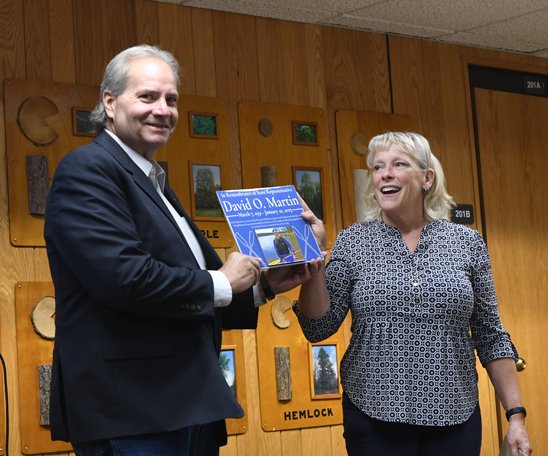The Driftless Area Land Conservancy gathered to celebrate their successes and share their plans for the future to a packed house at Wintergreen Resort on May Day. The Conservancy (DALC) is working to raise funds to purchase the Wintergreen Resort and establish it as the trail head for their 50-mile ‘Driftless Trail.’
Three speakers provided comments to the 400 people present for the celebration – Jordy Jordahl, Jen Filipiak, and Mark Cupp.
“I am humbled and honored to have been the DALC executive director during our awkward teenage years,” DALC executive director Jen Filipiak said in her address to the group. “Now, our organization is coming of age, and with lots of strategic thinking and planning, we’re about to make a big transition and step up to meet the hopes and dreams of our community for the next 25 years.”
“I want to tell you all that when we started this organization back in 2000, I don’t think any of us expected to be here today with almost 400 people and be able to say that our land trust has protected almost 10,000 acres, own seven preserves, is actively working to build a 50-mile walking path, and is now working to protect this gem on the bluff over the Lower Wisconsin River!” Jordahl enthused. “And in addition to the folks here, there are many members and supporters who couldn't join us today! Wow. I had some high hopes but wow.”
“All affiliated with DALC should be proud, incredibly proud, of the accomplishments we’ve heard ticked off today,” Lower Wisconsin State Riverway Executive Director Mark Cupp observed. “This is rare. Not every organization has this level of success, and is able to sustain it and continue to grow. Look around. Hundreds of people have gathered today to celebrate DALC’s 25th Anniversary, and last week, Governor Evers visited Wintergreen Resort to learn more about DALC’s work, recent initiatives, and those on the immediate horizon. The best is yet to come – I can feel it in my bones.”
Mixed in with the exhibits detailing key milestones of the group’s first 25 years and booths inviting interaction with partner organizations, was information lauding the positive impacts of the Knowles-Nelson Stewardship Program. The State of Wisconsin program has funded parks and trails, protected lakes and rivers, and conserved special places across Wisconsin for over 30 years.
Through this funding, up for reauthorization in the state biennial budget for 2025-2027, 750,000 acres have been protected, and more than 4,200 grants have been awarded to local governments and non-profit organizations to support parks, trails, boat launches and campgrounds.
Overall, in the last 30 years, this represents a $1.3 billion investment in Wisconsin’s land, water and way of life, and is estimated to cost each Wisconsin taxpayer only $11 per year. Supporters say that through this investment, $2.5 billion is returned to state residents every year through air and water filtration, carbon sequestration, recreation opportunities and flood protection. In addition, the funding supports 96,000 outdoor recreation jobs and the state’s $24 billion forestry economy.
Key milestones
• 2000-2005: DALC got its start in the year 2000 when a group of dedicated individuals gathered in Richland County. That group developed a collective vision to protect land and preserve the unique landscape and ecosystem of the Driftless Region. In 2001, they became a non-profit with a passionate team of volunteers. By 2003, they hired their first staff member, Doug Cieslak, as executive director and completed their first conservation easement. In 2005, DALC partnered with Prairie Enthusiasts and DNR using NRCS funding to protect farmland – a groundbreaking step that set the tone for future collaborations.
• 2006-2010: Despite the economic challenges of the 2008 recession, DALC persevered with safeguarding of vital lands. During these years, DALC employed two staff members, and had protected 2,287 acres. By 2010, they succeeded in protection of their largest parcel – the 548-acre Schuelke Easement. The effort was part of a broader initiative to connect properties within the Military Ridge Prairie Heritage Area.
“I can’t imagine a better place to live. I’ve seen so many beautiful farms disappear, and this was my chance – our chance – to make sure that our family says ‘thank you’ to those before us, and those to come, by making sure it will never become a sea of houses or paved over,” conservation easement partner Wayne Schuelke said.
• 2011-2015: Now with five staff members and 5,860 acres protected, DALC’s reach expanded. During these years, they protected six contiguous conservation easements, collectively known as the ‘Dry Dog Ranch’ in Iowa County. In 2012, they acquired the Erickson Conservation Area, their first owned preserve, and extended their efforts into Green and Lafayette counties. By 2015, DALC completed the Lowery Creek Watershed Plan, underscoring their focus on community centered ecosystem-level preservation and watershed health.
• 2016-2020: In these years, DALC relocated their offices, launched the Bloomfield Prairie Partnership, and publicly opposed the Cardinal Hickory Creek Transmission Line. In 2017, DALC earned the prestigious Land Trust Alliance accreditation and was named Wisconsin Land Trust of the Year. This recognition coincided with the formation of the Driftless Trail Advisory Team, a testament to DALC’s commitment to creating publicly accessible natural spaces. By 2020, in the midst of the pandemic, the group expanded their portfolio with the Wild Oaks Preserve in Dane County, and established Iowa County CLEA-N, responding to the community’s desire to work on locally sourced and locally used clean energy.
DALC’s vision for the Driftless Trail is a 50-mile hiking trail, hosted mostly by private landowners, that creates a corridor for land conservation, climate resiliency, exercise, education and connecting with nature. Though the trail is a long-term project that will take many years to complete, multiple trail segments are open now, including the Weaver Road Trail, a 1.1-mile loop located just north of Governor Dodge State Park, the Welsh Hills Trail, a two-mile loop on the Taliesin property, the Phoebe Point Trail, a 1.1-mile loop offering stunning overlooks of the Wisconsin River, and the Knobs Road Trail near Mill Creek. For more information and maps, go to www.driftlessconservancy.org.
• 2020-2025: During the last five years, DALC has grown to 11 staff members, and 9,550 acres protected. They facilitated their first land protection assist with Ringelstetter Wetland, which was later donated to the DNR. In 2023, they secured ‘Grasslands of Special Significance’ funding from the federal government for a conservation easement, and by 2024 had hired a development director and acquired two more properties – Dragon Woods and Big Rock.
Giving thanks
Jordy Jordahl was among the group of folks who came together to form the Driftless Area Land Conservancy, and served on the initial board until 2003. Over the last 25 years, Jordahl has worked on projects to protect special places like the Baraboo Hills, Lower Wisconsin Riverway, Military Ridge grasslands, and the Mississippi River watershed, while working as policy advisor to the Governor, legislative policy aide, director of intergovernmental relations for the Wisconsin Department of Administration, and for The Nature Conservancy.
Jordahl kicked off the 25th Anniversary celebration, giving thanks where thanks are due.
“Wow, what a great day in the Driftless,” Jordahl exclaimed. “I want to start by thanking the event sponsors, and the staff and volunteers of DALC for their hard work to make this celebration happen. I particularly want to thank Terry and Suzanne Shifflet, the owners of the Wintergreen Resort where we are gathering today, for allowing us to celebrate in this amazing place.”
Jordahl said that DALC is “all about the land,” but said that his comments would really be more about the people. He thanked the founding members of the group, Gathering Waters, Wisconsin’s alliance for land trusts.
“The support of Gathering Waters has been instrumental over the years,” Jordahl stated. “We wouldn’t have been able to do what we’ve done without their support.”
Jordahl also thanked DALC’s conservation partners, like the Nature Conservancy, Mississippi Valley Conservancy, and countless others.
“None of our key milestones would have happened without people working together,” Jordahl said. “And, the landowners we’ve partnered with have brought the land to the land trust. Owning land means caring for the land, and so that means we also need to thank our many volunteers, without whom our work wouldn’t be possible. It takes a community to protect a landscape.”
Jordahl said that Governor Evers, during his Earth Week visit to Wintergreen Resort, agreed that “we have to work together to protect places like this.” Jordahl explained that DALC is currently fundraising for $6 million to purchase the Wintergreen Resort.
Accomplishments
DALC’s Executive Director Jen Filipiak followed Jordahl’s comments, and touched on several big projects that the group had worked on in the last few years.
“We opposed construction of the Cardinal-Hickory Transmission Line after folks in our area asked us to do so,” Filipiak said. “Even though that transmission line is now up and running, the rallies we held were the biggest events we’ve ever held, and our efforts resulted in several modifications to the route so that it doesn’t cross conservation easements, and we’re still in court opposing the line’s crossing of the Upper Mississippi River Fish & Wildlife Refuge.”
Filipiak waxed particularly enthusiastic about their group’s development of the Driftless Trail, a walking trail intended to connect the Lower Wisconsin Riverway to Mt. Horeb and Governor Dodge State Park.
“In planning for the trail, we undertook a feasibility study with the National Park Service, and found out that, yes, we could do it,” Filipiak said. “In southern Wisconsin, 97% of the land is privately owned, so there’s a need for publicly available spaces.”
Filipiak said that the Driftless Trail encompasses “our entire mission in one project,” and enthused that “maybe one day the main trail head can be right here at the Wintergreen Resort.”
A worthy project
Last up to speak was Mark Cupp, executive director of the Lower Wisconsin State Riverway Board.
“I offer my sincere gratitude to the DALC founders for their vision, and the current and former board members for their continuing commitment to a vision for conservation in the Driftless,” Cupp said. “I offer my sincere gratitude to Jen and her team, and all former DALC staff members, for their commitment, their energy, their sacrifices, blood, sweat and tears in making DALC a great success. To the landowners, donors, partners, and supporters of DALC for the last 25 years, my thanks as well.”
Cupp pointed out that the Wintergreen Resort is located in the Lower Wisconsin State Riverway, a 92-mile riparian corridor and 10,000 acre property of both public and private lands extending from Prairie du Sac to Prairie du Chien.
“Thank you to Terry and Suzanne Shifflet for your incredible patience in working to fulfill your vision for the Wintergreen Resort, to ensure that it will be a place to be enjoyed by the public, and not a playground for the affluent,” Cupp remarked. “At this hour, on this first day of May 2025, I am optimistic that this special place will be acquired by DALC, and will become a destination within the Riverway.”
Cupp said that the Wintergreen Resort is one of the top three, if not the number one priority acquisition remaining in the Lower Wisconsin State Riverway. Reasons for that, according to Cupp, include aesthetics, native plant communities, fauna, wetlands, a mile of undeveloped shoreline, trails, and a building with potential that is “limitless.”
“However, we need to ensure that the dream is realized – we need to push to the finish line, and raise the necessary dollars to achieve the goal,” Cupp stated. “We need to support reauthorization of the Knowles-Nelson Stewardship Fund, we need to speak to legislators and local officials, and our friends and our neighbors about the importance of this acquisition.
“There’s a lot of negative noise in the world these days, and frankly, I have to tune it out and focus on other things – things I can change, things in my sphere of influence,” Cupp said. “These things include the Riverway or the family farm – places where I can find a refuge.”
Cupp said that in a recent moment of reflection, he thought of a favorite passage from Wendell Barry, ‘The Peace of the Wild Things.’
“This is why we need places to go to restore our soul, to calm our psyche, to hear a bird sing or see a Pasque flower in bloom,” Cupp said. “A place such as Wintergreen, or Big Rock, or the Driftless Trail. This is why we bond together and fight for those things in which we believe – to leave this world a better place for the next generation, and the generation after that.”




